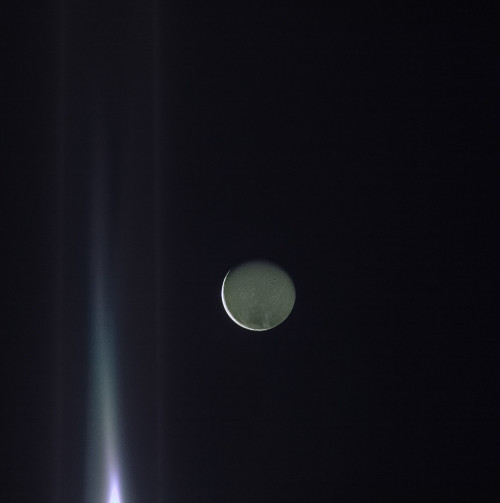🐈🍂🍁🐾
🐈🍂🍁🐾

@WeHeartIt /entry/27035659
More Posts from Monstrous-mind and Others

This image shows knots of cold, dense interstellar gas where new stars are forming. These Free-floating Evaporating Gaseous Globules (frEGGs) were first seen in Hubble’s famous 1995 image of the Eagle Nebula. Because these lumps of gas are dark, they are rarely seen by telescopes. They can be observed when the newly forming stars ignite, their intense ultraviolet radiation eroding the surrounding gas away and letting the denser, more resistant frEGGs remain. These frEGGs are located in the Northern Coalsack Nebula in the direction of Cygnus.
Credit: NASA, ESA, and R. Sahai (Jet Propulsion Laboratory); Processing: Gladys Kober (NASA/Catholic University of America)
🔭🌌


Dione (moon of Saturn) 2005 and 2015
Credit: NASA/JPL-Caltech/SSI/Kevin M. Gill
What's Up - December 2017
What’s Up For December? Geminid and Ursid meteor showers & winter constellations!

This month hosts the best meteor shower of the year and the brightest stars in familiar constellations.

The Geminds peak on the morning of the 14th, and are active from December 4th through the 17th. The peak lasts for a full 24 hours, meaning more worldwide meteor watchers will get to see this spectacle.

Expect to see up to 120 meteors per hour between midnight and 4 a.m. but only from a dark sky. You’ll see fewer after moonrise at 3:30 a.m. local time.

In the southern hemisphere, you won’t see as many, perhaps 10-20 per hour, because the radiant never rises above the horizon.

Take a moment to enjoy the circle of constellations and their brightest stars around Gemini this month.

Find yellow Capella in the constellation Auriga.

Next-going clockwise–at 1 o'clock find Taurus and bright reddish Aldebaran, plus the Pleiades.

At two, familiar Orion, with red Betelguese, blue-white Rigel, and the three famous belt stars in-between the two.

Next comes Leo, and its white lionhearted star, Regulus at 7 o'clock.

Another familiar constellation Ursa Major completes the view at 9 o'clock.

There’s a second meteor shower in December, the Ursids, radiating from Ursa Minor, the Little Dipper. If December 22nd and the morning of December 23rd are clear where you are, have a look at the Little Dipper’s bowl, and you might see about ten meteors per hour. Watch the full What’s Up for December Video:
There are so many sights to see in the sky. To stay informed, subscribe to our What’s Up video series on Facebook. Make sure to follow us on Tumblr for your regular dose of space: http://nasa.tumblr.com.
Astrobiology
A brief summary on astrobiology. Astrobiology, formerly known as exobiology, is an interdisciplinary scientific field concerned with the origins, early evolution, distribution, and future of life in the universe. Astrobiology considers the question of whether extraterrestrial life exists, and if it does, how humans can detect it.

Astrobiology makes use of molecular biology, biophysics, biochemistry, chemistry, astronomy, physical cosmology, exoplanetology and geology to investigate the possibility of life on other worlds and help recognize biospheres that might be different from that on Earth.

The origin and early evolution of life is an inseparable part of the discipline of astrobiology. Astrobiology concerns itself with interpretation of existing scientific data, and although speculation is entertained to give context, astrobiology concerns itself primarily with hypotheses that fit firmly into existing scientific theories.

This interdisciplinary field encompasses research on the origin of planetary systems, origins of organic compounds in space, rock-water-carbon interactions, abiogenesis on Earth, planetary habitability, research on biosignatures for life detection, and studies on the potential for life to adapt to challenges on Earth and in outer space

Some researchers suggested that these microscopic structures on the Martian ALH84001 meteorite could be fossilized bacteria.
Biochemistry may have begun shortly after the Big Bang, 13.8 billion years ago, during a habitable epoch when the Universe was only 10–17 million years old. According to the panspermia hypothesis, microscopic life—distributed by meteoroids, asteroids and other small Solar System bodies—may exist throughout the universe.

According to research published in August 2015, very large galaxies may be more favorable to the creation and development of habitable planets than such smaller galaxies as the Milky Way. Nonetheless, Earth is the only place in the universe humans know to harbor life.

Estimates of habitable zones around other stars, sometimes referred to as “Goldilocks zones, along with the discovery of hundreds of extrasolar planets and new insights into extreme habitats here on Earth, suggest that there may be many more habitable places in the universe than considered possible until very recently.

When looking for life on other planets like Earth, some simplifying assumptions are useful to reduce the size of the task of the astrobiologist. One is the informed assumption that the vast majority of life forms in our galaxy are based on carbon chemistries, as are all life forms on Earth. Carbon is well known for the unusually wide variety of molecules that can be formed around it. Carbon is the fourth most abundant element in the universe and the energy required to make or break a bond is at just the appropriate level for building molecules which are not only stable, but also reactive. The fact that carbon atoms bond readily to other carbon atoms allows for the building of extremely long and complex molecules.

The presence of liquid water is an assumed requirement, as it is a common molecule and provides an excellent environment for the formation of complicated carbon-based molecules that could eventually lead to the emergence of life. Some researchers posit environments of water-ammonia mixtures as possible solvents for hypothetical types of biochemistry. The kinds of living organisms currently known on Earth all use carbon compounds for basic structural and metabolic functions, water as a solvent, and DNA or RNA to define and control their form. However, If life exists on other planets or moons, it may be chemically similar; it is also possible that there are organisms with quite different chemistries—for instance, involving other classes of carbon compounds, compounds of another element, or another solvent in place of water.

False-color Cassini radar mosaic of Titan’s north polar region; the blue areas are lakes of liquid hydrocarbons. "The existence of lakes of liquid hydrocarbons on Titan opens up the possibility for solvents and energy sources that are alternatives to those in our biosphere and that might support novel life forms altogether different from those on Earth."—NASA Astrobiology Roadmap 2008.
A third assumption is to focus on planets orbiting Sun-like stars for increased probabilities of planetary habitability. Very large stars have relatively short lifetimes, meaning that life might not have time to emerge on planets orbiting them. Very small stars provide so little heat and warmth that only planets in very close orbits around them would not be frozen solid, and in such close orbits these planets would be tidally "locked” to the star.

The long lifetimes of red dwarfs could allow the development of habitable environments on planets with thick atmospheres. This is significant, as red dwarfs are extremely common.
Life in the Solar System
Thought on where in the Solar System life might occur, was limited historically by the understanding that life relies ultimately on light and warmth from the Sun and, therefore, is restricted to the surfaces of planets. The three most likely candidates for life in the Solar System are the planet Mars, the Jovian moon Europa, and Saturn’s moons Titan, and Enceladus.



Another planetary body that could potentially sustain extraterrestrial life is Saturn’s largest moon, Titan. Titan has been described as having conditions similar to those of early Earth. On its surface, scientists have discovered the first liquid lakes outside Earth, but these lakes seem to be composed of ethane and/or methane, not water. Some scientists think it possible that these liquid hydrocarbons might take the place of water in living cells different from those on Earth.


Rare Earth hypothesis
The Rare Earth hypothesis postulates that multicellular life forms found on Earth may actually be more of a rarity than scientists assume. It provides a possible answer to the Fermi paradox which suggests, “If extraterrestrial aliens are common, why aren’t they obvious?” It is apparently in opposition to the principle of mediocrity, assumed by famed astronomers Frank Drake, Carl Sagan, and others.

The Principle of Mediocrity suggests that life on Earth is not exceptional, and it is more than likely to be found on innumerable other worlds. read more
The evil in the world comes almost always from ignorance, and goodwill can cause as much damage as ill-will if it is not enlightened. People are more often good than bad, though in fact that is not the question. But they are more or less ignorant and this is what one calls vice or virtue, the most appalling vice being the ignorance that thinks it knows everything and which consequently authorizes itself to kill. The murderer’s soul is blind, and there is no true goodness or fine love without the greatest possible degree of clear-sightedness.
The Plague / Albert Camus

Puraten10 on Instagram
🐈⬛🐈🏔️🌌






Winter views, Sweden
stepsisters
Soon... Very soon 🌬🍃🍁🍂🎃🍂🍁🐈

🎃🍁🍂🐈🐾🍂🍁🎃

🐈⬛🐈🎃🍂🍁


When witches go riding, and black cats are seen, the moon laughs and whispers, 'tis near Halloween 🎃🖤🐾
-
 happyeaglemilkshake liked this · 8 months ago
happyeaglemilkshake liked this · 8 months ago -
 birdcageromance liked this · 1 year ago
birdcageromance liked this · 1 year ago -
 margatechamomile liked this · 1 year ago
margatechamomile liked this · 1 year ago -
 emdroid liked this · 1 year ago
emdroid liked this · 1 year ago -
 thatcreepyplacewithallthecrows reblogged this · 1 year ago
thatcreepyplacewithallthecrows reblogged this · 1 year ago -
 mystic-mead0w reblogged this · 1 year ago
mystic-mead0w reblogged this · 1 year ago -
 kollabierteseele liked this · 1 year ago
kollabierteseele liked this · 1 year ago -
 mychemicalvampirebat reblogged this · 1 year ago
mychemicalvampirebat reblogged this · 1 year ago -
 ubreblanca liked this · 2 years ago
ubreblanca liked this · 2 years ago -
 wisedeputydiplomatbailiff liked this · 2 years ago
wisedeputydiplomatbailiff liked this · 2 years ago -
 mahmoudmohamed22 reblogged this · 3 years ago
mahmoudmohamed22 reblogged this · 3 years ago -
 mahmoudmohamed22 liked this · 3 years ago
mahmoudmohamed22 liked this · 3 years ago -
 emberdune reblogged this · 3 years ago
emberdune reblogged this · 3 years ago -
 trappedinavelociraptor liked this · 3 years ago
trappedinavelociraptor liked this · 3 years ago -
 thumbikin reblogged this · 3 years ago
thumbikin reblogged this · 3 years ago -
 peneigh-dzredfohl reblogged this · 3 years ago
peneigh-dzredfohl reblogged this · 3 years ago -
 peneigh-dzredfohl liked this · 3 years ago
peneigh-dzredfohl liked this · 3 years ago -
 pumpkinsae reblogged this · 3 years ago
pumpkinsae reblogged this · 3 years ago -
 pumpkinsae liked this · 3 years ago
pumpkinsae liked this · 3 years ago -
 waitingonfall reblogged this · 3 years ago
waitingonfall reblogged this · 3 years ago -
 sirens-call liked this · 3 years ago
sirens-call liked this · 3 years ago
My ambition is handicapped by laziness. -C. Bukowski Me gustan las personas desesperadas con mentes rotas y destinos rotos. Están llenos de sorpresas y explosiones. -C. Bukowski. I love cats. Born in the early 80's, raised in the 90's. I like Nature, Autumn, books, landscapes, cold days, cloudy Windy days, space, Science, Paleontology, Biology, Astronomy, History, Social Sciences, Drawing, spending the night watching at the stars, Rick & Morty. I'm a lazy ass.
222 posts